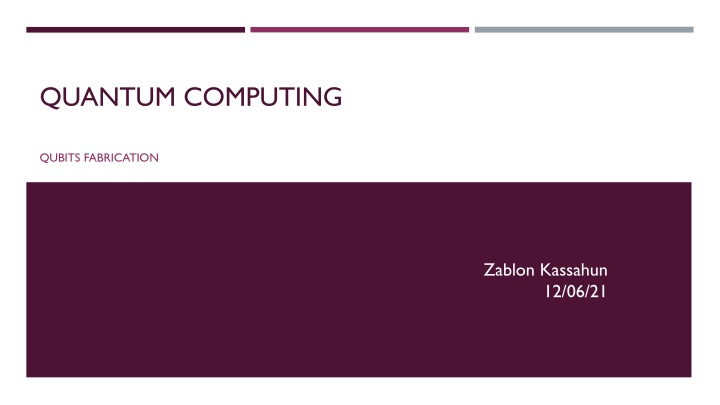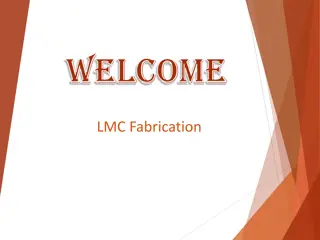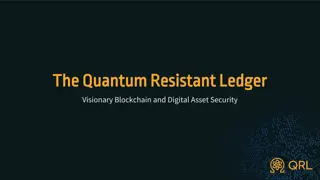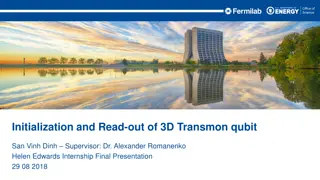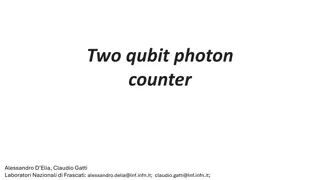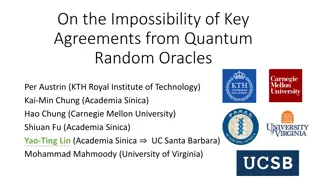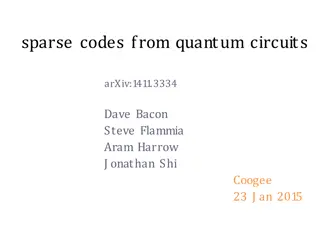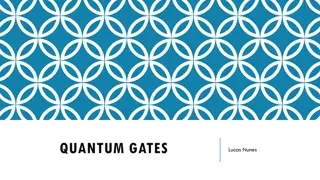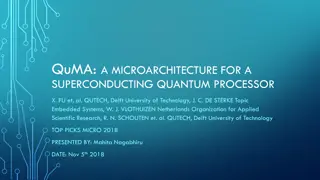Quantum Computing: Qubits Fabrication Approaches and Challenges
Describing the behavior of particles at small distances and energy scales, quantum mechanics encompasses superposition, coherence, entanglement, and measurement. Quantum computing leverages interference, superposition, and entanglement to achieve unprecedented computational power with qubits. Various qubit fabrication methods including Ion Traps, Superconducting, Photonic, Neutral Atom, and Semiconductor technologies are explored with their unique characteristics and challenges.
Download Presentation

Please find below an Image/Link to download the presentation.
The content on the website is provided AS IS for your information and personal use only. It may not be sold, licensed, or shared on other websites without obtaining consent from the author.If you encounter any issues during the download, it is possible that the publisher has removed the file from their server.
You are allowed to download the files provided on this website for personal or commercial use, subject to the condition that they are used lawfully. All files are the property of their respective owners.
The content on the website is provided AS IS for your information and personal use only. It may not be sold, licensed, or shared on other websites without obtaining consent from the author.
E N D
Presentation Transcript
QUANTUM COMPUTING QUBITS FABRICATION Zablon Kassahun 12/06/21
OUTLINE Quantum Mechanics & Properties Quantum Computing What is Qubits Different Qubits Fabrication Approach Challenges Future Outlook Summery References Possible Final Exam topics and questions
QUANTUM MECHANICS & PROPERTIES Describes the behavior of particles at very small distances and energy scales Wave - Particle duality General has both wave and particle - like properties Superposition Quantum objects can exist in multiple states all at once, with each of the states adding together and interfering like waves to define the overall quantum state. Coherence When a quantum system s state can be described by a set of complex number, one for each basis state of the system. Entanglement Measurement of the state of one particle collapses the state of the other particles, even if the particles are far apart with no apparent way to interact. A special property of some (but not all) multiparticle superposition states Measurement Where the measurement yields a well-defined value, the system is left in a state corresponding to the measured value,. Fundamentally changes it, know as collapsing the wave function.
QUANTUM COMPUTING Leverages the quantum mechanical properties of interference, superposition, and entanglement to perform computations. Manipulating particles at the microscopic scale Exponential difference in processing power compared to classical computing that relies on transistor technology. Uses Quantum bits or Qubits Qubit has two distinguishable configurations corresponding to the bit values 0 and 1. With superposition principle applied: the qubit's state can be any combination, or superposition, of the two configurations. When extended to many qubits, this ability to be in all possible binary states at the same time gives rise to the potential computational power of quantum computing. Has an enormous quantum parallelism.
QUBITS Building blocks of quantum computer A Quantum bit or Qubit has two quantum states Can be in either state and it can also exit in a superposition of the two. Subjected to incompatible measurements, and even be entangled with other quantum bits. Any given qubit wave function may be written as a linear combination of the two states, each with its own complex coefficient ai: | = a0 | 0 + a1 | 1 Ex: If qubit A is entangled with qubit B, and at some later time qubit B becomes entangled with qubit C, it is likely that qubit A is now also entangled with qubit C.
QUBITS FABRICATION Many qubits approaches some occurring naturally and others fabricated/engineered. Ion Traps Superconducting Photonic Neutral Atom Semiconductor
ION TRAPS QUBITS Atomic ions are trapped in space using electromagnetic fields Operated in a vacuum to avoid interactions with background molecules in the environment. Laser cooled to near the ground state of motion in order to remove random variations that can affect their multiqubit operations. A combination of electric and magnetic fields (Penning trap) or a time-dependent electric field (Paul trap) must be used to trap arrays of atomic ions. Two main types of trapped ion qubits: optical qubits and hyperfine qubits.
PAUL TRAP Radio frequency (RF) signal is applied to two electrodes arranged in parallel to ground electrodes, to form a quadrupole RF field. At the quadrupole null where the RF field vanishes atomic ions feel a trapping potential, which typically takes the shape of a line. Trap structures Traditional: are constructed by machining and assembling metal parts New design: the electrodes of a Paul trap onto a planar geometry and use semiconductor microfabrication technologies. Microfabrication technologies enable the creation of more complex trap structures and new mechanisms for manipulating the trapped ions. Accelerated the development of advanced features of the ion traps by integrating various optical and microwave components Shuttling across junctions, critical for scaling up the number of qubits in these systems
OPTICAL QUBIT Ground electronic state and a metastable excited electronic state of an ion, for which the energy difference between these levels is equal to the energy of a photon from the right color optical laser, the qubit laser. Efficiencies better than 99.9 percent, with coherence times in the range of 1 to 30 seconds. Technical challenge: maintaining control of the qubit laser to enable precise and coherent control of the qubits. Requires stabilization of the laser s output frequency over the time frame of qubit coherence Stabilization of the overall optical path lengths that the laser beam traverses to within a fraction of the optical wavelength over the duration of the quantum computation This optical frequency precision is just achievable in 2018 with state-of-the art laser sources.
HYPERFINE QUBIT Uses a hyperfine levels of the ground electronic state of an atomic ion with nonzero nuclear spin. The magnetic field can often be designed such that the energy separation between the two qubit states (typically corresponding to the microwave frequency range of 1 to 20 gigahertz [GHz]) is insensitive to the changes in the magnetic field to first order, which lead to long coherence times (1 to 1,000 seconds). Coherent control of hyperfine qubits also requires precise experimental control of the radiation in this case, either microwave frequencies and phases, or the frequency difference of two laser fields that correspond to the qubit frequency. Much more manageable at microwave than at optical frequencies
SUPERCONDUCTING QUBITS Require milli-Kelvin (mK) temperatures to operate. A superconducting qubit can exist in a series of quantized energy states Uses a simple inductor and capacitor circuit, with quantized energy at low temperatures. To make the energy difference between its levels distinct, a nonlinear inductive element, the Josephson junction (JJ) is added to the circuit. There are number of ways the inductor, capacitor, and JJ can be arranged to create a qubit Fixed-frequency versus tunable qubits Static versus tunable coupling The circuits include a simple mechanism to couple the qubit to its 5 GHz microwave control signal and to a superconducting resonator, typically designed to operate at around 7-8 GHz, which reads out the qubit state using the circuit quantum electrodynamics architecture.
SUPERCONDUCTING CIRCUITS Superconducting circuits are manufactured using a multistep additive and subtractive fabrication process involving lithographic patterning, metal deposition, etching, and controlled oxidation of thin, two-dimensional films of a superconductor such as aluminum or niobium. Circuits are fabricated on silicon or sapphire substrates, leveraging techniques and materials compatible with silicon CMOS manufacturing. Devices are placed inside a copper or aluminum package that provides an engineered electromagnetic environment with requisite signal lines and is thermally anchored to the 10-mK stage of a dilution refrigerator. The toolbox of superconducting circuits comprises resonators and bias lines, in addition to the qubits themselves. The properties of these building blocks can be engineered by varying circuit parameters and interconnected with tailored couplings.
PHOTONIC QUBITS Photons interact weakly with matter and with each other, giving them good coherence Each photon carries an electromagnetic field with a specific direction The qubits are individual photons, with the two different photon polarizations (horizontal polarization and vertical polarization) serving as the two qubit states. Single qubit gates can be implemented with standard passive optical components (phase shifters and beam-splitters), used to rotate the polarization, but two-qubit gates require a low-loss nonlinearity, which is difficult to achieve.
NEUTRAL ATOM QUBITS Like trapped ion systems, lasers are used to cool the atoms to micro-Kelvin temperatures, and then these very cold atoms are loaded into optical traps in a vacuum system. Another laser is used to initialize the state of the qubit, logic gates are carried out via a combination of optical and microwave fields, and the output is detected via resonance fluorescence. Two methods to achieving two-qubit gates One method requires moving the desired atoms close together; since the atoms are neutral, the spacing must be small, so accurate enough control of moving traps and the motional states of the atoms is challenging. The other method is to temporarily excite the atoms to highly excited Rydberg states (where an electron is very weakly bound to the atom), in which they have strong mutual dipolar interactions. This second approach has been pursued by several groups.
SEMICONDUCTOR QUBITS Divided into two types, depending on whether they are manipulated Optically or Electrically. Optically Gated Qubits a system in a semiconductor (typically either a defect in a crystal or a quantum dot in a host material) whose optical response depends on the quantum state of that defect/dot. This defect, which consists of a nitrogen atom substituting for a carbon together with a vacancy, is a paramagnetic center that can be manipulated and measured optically. Quantum coherence in these systems can persist at temperatures as high as room temperature. Two-qubit gates: requires qubits to be extremely close together (tens of nanometers), which makes optical addressing of the detects extremely hard, or requires them to be coupled using photons. Using photons allows the qubits to be spaced meters apart, but because the interaction between the defects and photons tends to be weak, entanglement-generating gates tend to be slow (typically, many attempts at the entangling operation must be made before one succeeds).
CONTINUED SEMICONDUCTOR QUBITS Electrically Gated Qubits Qubits are defined and manipulated by applying voltages to lithographically defined metal gates on semiconductor surfaces. The fabrication and lithographic methods are very similar to those used in classical electronics. The first electrically gated semiconducting qubits were fabricated in heterostructures of gallium arsenide and aluminum gallium arsenide In this materials system the decohering effects of the nuclear spins in the host material greatly complicated the implementation of high-fidelity gate operations. Qubits in silicon-based structures Greatly reduced decoherence from nuclear spins, because natural silicon has an abundant zero-spin nuclear isotope, and isotopically enriched silicon in which more than 99 percent of the nuclei have spin zero has recently become available. Development of new device designs that enabled more compact gate patterns and enabled a transition from doped to accumulation- mode devices. These changes enabled the fabrication of devices with small (~25 nm) dots with reasonable device yields. Electrically gated semiconducting qubits have the potential for scalability to billions of qubits, because the methods used for fabrication are so similar to those used for classical electronics and the qubit footprints are substantially less than a square micron.
CHALLENGES Other trapped ion and superconducting qubit approaches, the rest are still focused on creating two-qubit gates if not single-qubit. Scale-up is an issues shared by all approaches Lower qubit error rates in large systems while enabling measurements to be interspersed with qubit operations. Improving physical qubit fidelity - through improvements to fabrication and control- is paramount to demonstrating logical qubits or even a machine with physical qubits that can cascade an interesting number of qubit operations before losing coherence.
FUTURE OUTLOOK The next step is to increase the number of qubits in the quantum computer. One will be able to build ICs with hundreds of superconductor qubits in the near future using procedures very similar to the methods used for today s 20-qubit ICs. In fact, by mid-2018 several companies have announced ICs that contained order of 50 qubits. Unlike conventional silicon scaling, where creating the manufacturing process for the more complex integrated circuit set the pace of scaling, for quantum computing, scaling will be dictated by the degree of difficulty in obtaining low error rates with these larger qubit systems, a task that requires joint optimization of the IC, package, control and measurement plane, and the calibration method used. Increasing the number of qubits in a quantum processor or chip, the scaling will become easier using a modular approach, where a number of chips are linked together to create a larger machine rather than creating a larger chip. A modular design will require the development of a fast, low error rate quantum interconnection between the modules; with photonic connections the most promising due to their speed and fidelity.
SUMMARY Today's physical quantum bits (Qubits) are microscopic in size and confined to superconducting circuits, nanoscale semiconductor islands, impurities in solids, nuclei of molecules, or electromagnetically trapped atoms or ions. But the devices needed for confinement substantially increase the bulk of the 'quantum core . Significant materials, fabrication, and measurement challenges must be overcome to demonstrate even single-qubit gates of a topological quantum computer. To get the power of quantum computing, qubits must be entangled - the state of any qubit must be correlated with the states of the other qubits. To form such a dependence between two qubits, they need to interact either directly or indirectly via an intermediate quantum system. To prevent the qubit energy from coupling with the environment, it is held in localized, well-isolated spots. Distributing the energy over a wide area for two qubits to interact would also expose those qubits to a lot of environment, which in today s technologies greatly shortens the coherence time. For all qubit fabrications, the first major challenge is to lower qubit error rates in large systems while enabling measurements to be interspersed with qubit operations.
REFERENCES Arute, F. et al. Quantum supremacy using a programmable superconducting processor.Nature 574 (2019). Vion, D. et al. Manipulating the quantum state of an electrical circuit.Science 296 (2002). M. A. Nielsen and I. L. Chuang, Quantum Computation and Quantum Information, Cambridge University Press (2000) D. P. DiVincenzo, The physical implementation of quantum computation, Fortschr. Phys. 48 (2000) J. P. Dowling and G. J. Milburn, Quantum technology: The second quantum revolution, Philos. Trans. R. Soc. London, A 361 (2003). T. D. Ladd, F. Jelezko, R. Laflamme, Y. Nakamura, C. Monroe, and J. L. O'Brien, Quantum computers, Nature 464, 45 (2010). C. Monroe and J. Kim, Scaling the ion trap quantum processor, Science 339, 1164 1169 (2013). W. D. Oliver and P. B. Welander, Materials in superconducting quantum bits, MRS Bull. 38 (2013). G. Wendin, Quantum information processing with superconducting circuits: A review, Rep. Prog. Phys. 80, 106001 (2017). DiCarlo, L. et al. Demonstration of two-qubit algorithms with a superconducting quantum processor. Nature 460, (2009) J. Stuart, R. Panock, C. Bruzewicz, J. Sedlacek, R. McConnell, I. Chuang, J. Sage, and J. Chiaverini, Phys. Rev. Appl.11, 024010 (2019).
POSSIBLE FINAL EXAM TOPICS AND QUESTIONS 1. What are the implications of having a quantum computer, for example on signals intelligence, communications, banking, and commerce? 2. Given the current state of quantum computing and recent rates of progress, it is highly unexpected that a quantum computer that can compromise RSA 2048 or comparable discrete logarithm-based public key cryptosystems will be built within the next decade. 3. How is quantum bits (qubits) distinct from classical bits? 4. In superconducting quantum computers, qubits for digital quantum computing and quantum simulation are most commonly fabricated from? 5. For digital quantum computing, the qubit operation frequency is typically at?
